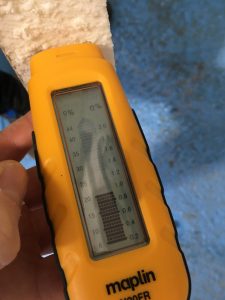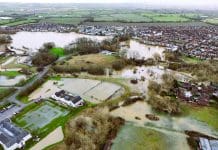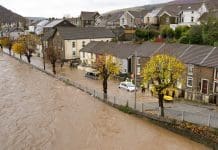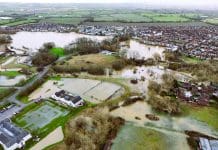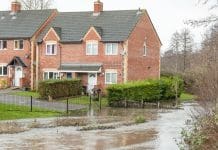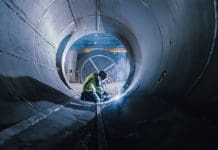Aquobex has developed a testing protocol for assessing and rating the performance of different approaches to flood resilience
The flood resilience industry is growing rapidly and is being pushed forward by both national policy and market forces. However, the danger of this fast pace of growth is that it is ploughing ahead without the empirical evidence needed to base design of defences on. Expert knowledge based on experience in other fields, such as basement waterproofing and historical repairs, is invaluable but needs to be drawn together in a strategic and comprehensive way that makes it directly applicable to flood protection.
As a result of Knowledge Transfer Partnership, funded by Innovate UK, Aquobex has been developing testing protocols for assessing the performance of different approaches to flood resilience. This project started in January 2017 and has been a huge success in harnessing the expert knowledge of building physics at the School of Architecture at Oxford Brookes University, building on their many years of experience of testing for industry.
The project has led to the development not only of a testing protocol for the assessment of flood resilient measures but also to the development of a rating system for these measures. Having established a baseline against which to compare and assess, we are now able to offer solutions that offer flood resilience, rated on a Bronze, Silver and Gold rating system.
The project
A project emerged that offered us the opportunity to be involved in the installation of a range of flood protection measures in a property in Carlisle, which formed part of a project funded by the Prince’s Trust as a means of promoting property-level flood resilience. We were excited to be involved in this project, partnering with others in the industry, but we wanted to ensure that any measures installed were tried and tested before being installed. This also offered us a chance to apply our methodologies for testing of details and systems.
The house
The house was originally a barn with a stonework wall and was converted by building a blockwork inner leaf and insulated internally. When it was flooded in 2015, the water reached a level of one metre and the internal finishes and insulation were removed up to that level. Our challenge was to stop water from coming into the house and to ensure that if water did get in, damage to the internal finishes would be minimised.
The tests
We wanted to replicate the situation on site as much as possible so in our test tank we built a concrete blockwork wall and a concrete floor slab to replicate the structure, assuming the worst-case scenario of the stonework external leaf offering little or no resistance. We then simulated a flood by applying a full head of water acting against the blockwork externally for 48 hours and then simulated the over-topping of barriers with water internally for 24 hours. Then we carried out the ‘drying’ phase, constantly monitoring the moisture levels of all the elements.
Before the tests, we took moisture measurements of all the different elements including the blockwork, render, board, insulation and floor. To detect entry of water into the cavity between the render and the insulation, we used moisture level sensors at different heights.
The Bronze Standard: Replaceable
The first round of tests highlighted some issues with the system. We observed a high level of moisture build-up in the cement-based render applied to the internal face of the blockwork. It became clear that while this solution could offer some resistance to the passage of liquid water, the build-up of moisture between layers could provide problems of mould growth and a reduction in the thermal performance of the wall.
The Silver Standard: Repairable
The second round of tests involved simultaneous testing of two alternative possible solutions. One using the cement-based render with a different internal build-up and the other a polyurea spray-on coating to the internal face of the blockwork. We observed that the polyurea coating outperformed the cement-based render in maintaining low levels of moisture penetration during the 48-hour external test. However, we were still experiencing moisture between the layers during the 24-hour tests and prolonged drying times.
The Gold Standard: Resilient
Finally, after three rounds of testing, we came to a solution that offered the best performance during both phases of testing and particularly in the drying phase. The approach that was finally adopted was to allow water to enter into a cavity between the coating and the insulation during internal flooding and to also allow it to leave via a small drainage gap at the bottom of the wall, highlighting the benefit of a resilience approach to detail design.
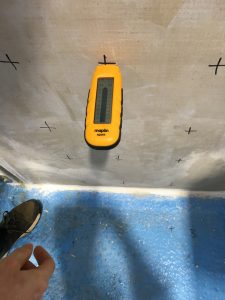 The results
The results
As a result of the testing, we were able to demonstrate the importance of testing solutions before installing them and that every building is different, offering unique problems that need to be overcome. Our tests illustrate that a resilient approach to detail design, assuming some entry of water and allowing for quick drying, is a robust approach but requires an evolutionary design process backed by evidence.
This testing has led to us being able to offer solutions rated as Gold, Silver or Bronze, with Gold offering a solution that requires no recovery after a flood, Silver requiring some repairs and maintenance, and Bronze requiring replacement. This offers a unique pricing opportunity for homeowners and designers, offering the appropriate solution for the property and the potential flood risk.
John Alexander
Managing Director
Aquobex ltd
Tel: 01923 518582
Twitter: @aquobex
Please note: this is a commercial profile.


